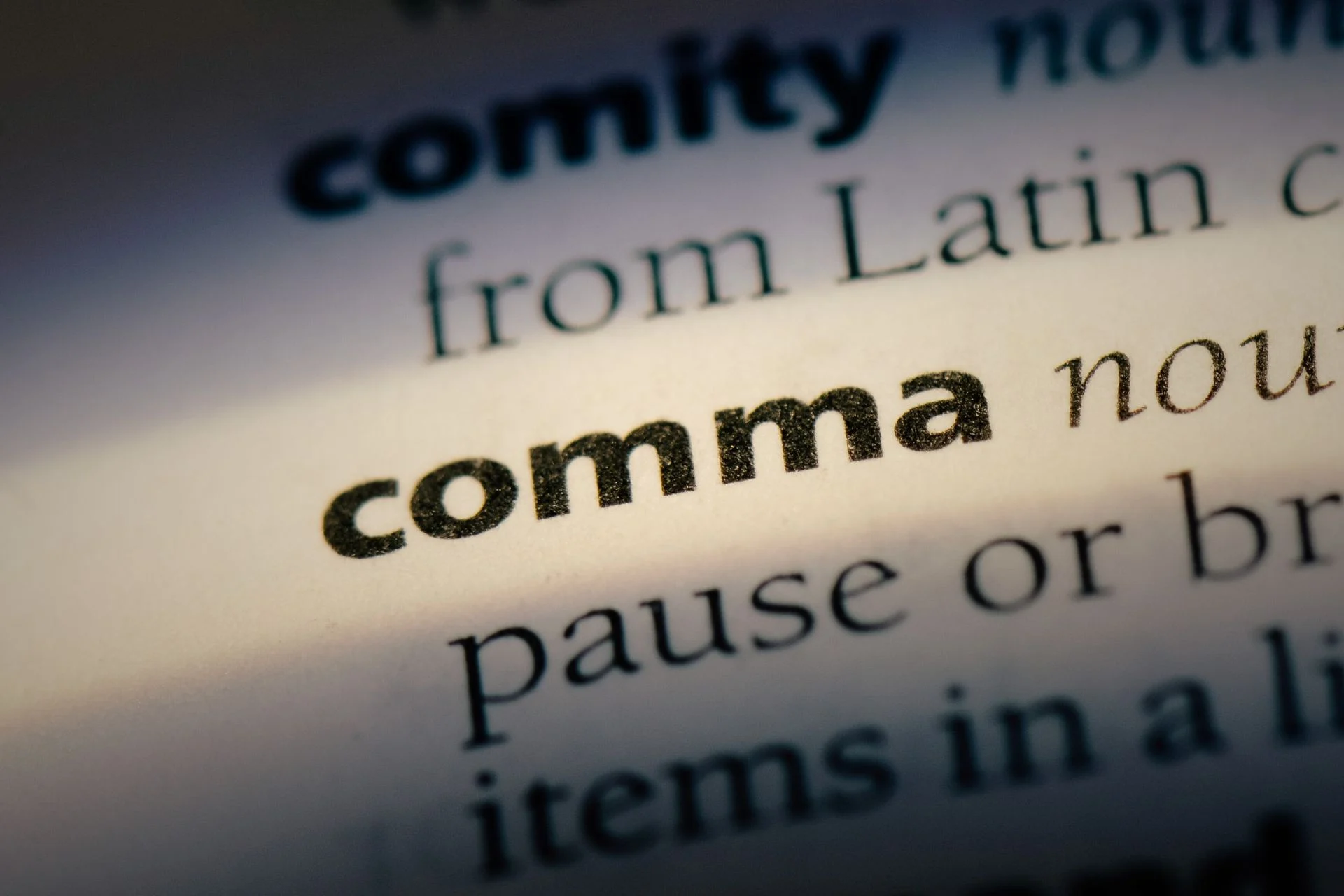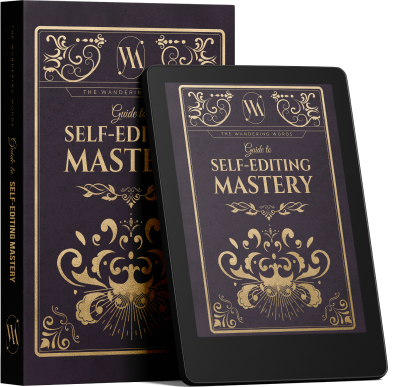Our Guide to Self-Editing Mastery has helped thousands of authors just like you:
- Pre-edit their books with ease
- Avoid the most common writing errors
- Quickly identify spelling & grammar mistakes
- Be more prepared for professional editing
Our Guide to Self-Editing Mastery has helped thousands of authors just like you:


Confused about when to use commas? Don’t worry; I think we can all agree commas are tricky. And these rules for using commas can help.
Commas are the smallest break in a sentence, and they are used to mark a slight pause. There are many rules for using commas; however, some styles favor more commas, while others prefer less. Ultimately, you should keep clarity and the reader experience in mind as you determine when to use commas, and knowing the rules will help smooth the reading experience.
Here is a crash course of the most common rules for using commas according to The Chicago Manual of Style. We’ll breeze through the comma rules, explore each with some examples, and end with the dreaded comma splice.
First up, the Oxford comma.
Commas are used in a set of three or more elements with a conjunction joining the last two, and it’s strongly advised to use the Oxford comma before the conjunction.
Examples:
Eat your peas, carrots, and beans.
Apples, pears, and strawberries are my favorites.
Here’s what might happen without the Oxford comma:
I attribute my success to my parents, my husband and my mentor. (Reads like your husband and your mentor are your parents, not that you attribute your success to your parents, husband, and mentor.)
We invited the strippers, JFK and Stalin. (Reads like JFK and Stalin are the strippers who were invited, not that JFK and Stalin were invited as well as the strippers.)
Names or terms are set off by commas when they are a direct address.
Examples:
Maverick, when is that paper due?
How are you doing, Tara?
Yes, ma’am.
Today is the day, my friends, that we discuss a schedule.
Quotes in the form of dialogue or text are introduced with a comma, and commas are required despite the position of the text relative to the quote.
But, if introduced by “that,” “whether,” or “if,” no comma is necessary.
Examples:
He said, “Watch where you’re going.”
“Have a great day,” I said.
“Two is better than one,” Mark replied, “but maybe not in this situation.”
My dad said that “it takes two to tango.”
For more on the use of dialogue tags, see our post: “How to Use Dialogue Tags Without Ruining Your Story’s Flow.”
A comma will set off the “not” phrase.
Examples:
The grass is yellow, not green.
She wants you, not your brother, to do the dishes.
If a comma is placed before an element, one must be placed after it to set off the element.
Examples:
I was born January 5, 1981, at a hospital north of here.
Skiing in Aspen, Colorado, is a huge attraction.
When a clause that cannot stand alone precedes one that can, a comma is used between them.
Examples:
If you keep doing that, you’ll get a headache.
Whether you like it or not, we’re going.
Clauses that can stand alone joined by “and,” “but,” “so,” “or,” and “yet” contain a comma before the conjunction.
Examples:
I like to watch TV, but sometimes I would rather take a walk.
It was raining, so we took an umbrella.
She jogged, and I drove beside her.
Restrictive clauses (those that provide essential information to the sentence) are introduced by “that” without commas.
Example:
It was the third one that I was supposed to use.
Nonrestrictive clauses (those that could be omitted without changing the meaning of the sentence) are introduced by “which” and commas.
Example:
The symbol, which was easy to see, was on the right.
A nonrestrictive word or phrase that provides explanation is set off by commas.
Example:
Her fourth book, How to Save Lives, was a bestseller.
A restrictive word or phrase essential to the meaning of the sentence will not include commas.
Example:
The book How to Save Lives was a bestseller.

Check if the company uses a comma in their official business name to offset Inc. or Ltd. If a comma is used, a second comma will need to be placed after the abbreviation in the middle of a sentence.
Examples:
The TJX Companies, Inc., is a worldwide retailer.
Time Inc. was founded in 1992.
These are preceded by a comma, but a comma only follows if necessary.
Examples:
Loud noises like banging, crashing, etc. came from the other room as the furniture was moved around.
The boy recited his letters, numbers, and so forth for the teacher’s examination.
To see the benefits, examples, resources, etc., turn to the appendix.
The article written by Tonnes et al. was informative.
After reading the article by Tonnes et al., I might have a different opinion.
Place a comma between repeated adjectives.
Example:
I reviewed the document many, many times.
The use of commas with “too” and “either” depends on author preference. Commas with “too” in the middle of a sentence might help with clarity, though.
Examples:
We went along, too.
We went along too.
She wouldn’t sit either.
She wouldn’t sit, either.
I, too, was interested.
I too was interested.
Phrases meant as an explanation or comment in the middle of a sentence can be set off using commas. Think of the commas meaning the phrase could be removed from the sentence and it would still make sense. The same is true when the phrase is at the end of a sentence.
Examples:
There were two, as far as we knew, options for payment.
He was the best, and the strongest, athlete on the team.
The two of us stared at the market, if you could call it that.
Explanatory alternatives are also set off by commas when they interrupt a sentence. But no commas should be used when the alternative is not explanatory.
Examples:
Pop, or soda, was the most popular drink.
You can use bananas or apples for the recipe.
Participial Phrases: Beginning with a past or present participle and modifying a noun, these phrases require a comma.
Example:
Having finished her work, Lara settled in to relax.
Adverbial Phrases: Usually modifying a verb or sentence, and beginning with a preposition—use your judgement with these. Shorter phrases are less likely to need the comma.
Examples:
With a nod of his head, he confirmed the rumor was true.
In 2019 we sold the house.
Dependent Clauses: A dependent clause (can’t stand on its own) preceding an independent clause (makes sense on its own) needs a comma.
Examples:
If you want to go, I will get a ticket for you.
Whether you like it or not, you have to go to class.
“Yes,” “no,” “well,” etc.: A comma should be used unless part of the phrase.
Examples:
Yes, I agree.
No, the waist is too tight.
Well, how would you describe it?
Well then, we’ll have to sell it.
“Oh” and “ah”: Commas are used with exclamations as long as they are not part of a phrase.
Examples:
Oh, that’s great!
Ah, I see.
Oh no!
Oh my God!
If the conjunction is part of one of the phrases, the comma comes after the conjunction.
Examples:
They were tired and, judging by the shivering, cold.
Laura waved and, having already gathered her belongings, departed.
If the conjunction joins two independent clauses, the comma comes before the conjunction.
Examples:
We stared at the clock, and after the bell rang, we bolted for the door.
Tim needed some more milk, but after checking his watch, he decided he didn’t have time to grab any.

Commas aren’t usually used to separate two parts of a compound predicate—unless preventing misreading.
Examples:
Beth stood and shut the door.
Wynna lifted her eyes to the scoreboard and covered her mouth.
Wynna lifted her eyes to the man who stood before the scoreboard, and laughed.
When “then” is used in place of “and then,” a comma precedes it.
Example:
Trinity whipped around, then glared at her brother.
Water poured from the hole, then spread across the floor.
When there are two or more adjectives before a noun that could be joined by “and” without affecting meaning, they are separated by commas.
Examples:
It would be a long, painful process.
Her bright, wide smile greeted me.
The single brown duck waddled in my direction.
Sentences with “not only . . . but” contain commas if two independent clauses are joined. Commas aren’t necessary with dependent clauses.
Examples:
It was time to not only put things into first gear but also to connect with our inner potential.
His teeth were not only brighter but straighter after dental work.
Not only did Ana break the record, but she was the first one over the finish line.
Commas set off “however,” “therefore,” and “indeed” when they’re not essential to the clause.
Examples:
The timing was, however, quite off.
It seemed that, indeed, the house was blue.
It was necessary for however many instances.
But use semicolons when these words join two independent clauses.
Example:
My dog loves all people; however, she doesn’t get along with other dogs.
Commas are used with relationships when:
(1) there is an adjective that uniquely identifies the term
Example:
My neighbor’s pug, Pickles, is friendly.
(2) when the name comes before the term
Example:
Trixie, Cameron’s sister, is the one you’re thinking of.
Commas are also generally used when the name is the only one.
Example:
Special thanks to my husband, Greg, for his support. (I have one husband.)
But the commas can be omitted if this is unknown.
Example:
Dede’s brother Chaz was the first one in line. (We don’t know if Dede has one or more brothers.)
The commas can be omitted to avoid awkwardness with possessives.
Example:
My husband Gary’s support was appreciated.
Rather than:
My husband’s, Greg’s, support was appreciated.
Well, that was certainly a discussion! Now that we’ve gone through the common rules for using commas, let’s end with the mistake made most often: comma splices.
These are the ones to watch out for. A comma splice occurs when two independent clauses are joined by a comma without a conjunction. If both clauses can stand alone, a comma is not appropriate.
For example:
There were too many cooks in the kitchen, none of them would leave.
This is a comma splice and can be fixed by adding “and” after the comma, using a semicolon in place of the comma, or breaking the independent clauses into two sentences.
Here are correct examples:
There were too many cooks in the kitchen, and none of them would leave.
There were too many cooks in the kitchen; none of them would leave.
There were too many cooks in the kitchen. None of them would leave.
There you have it! You now know when to use commas—and when not to use them. Feel like you can confidently tackle the commas in your writing or someone else's? You should!
Get out there and demonstrate your knowledge of the comma rules, my friend.

